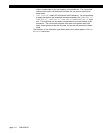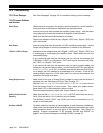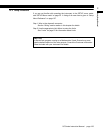
SC Series Instruction Manual page 119
High-Level Input Channel12
12.6.7
DAC SETUP
Sub-Menu
This sub-menu contains four items that control the Digital-to-Analog Converter
(DAC) output of the channel.
DAC. CHANNEL
Menu Item
This chooses which channel will drive the DAC output. Normally, the DAC located
on a particular channel will be driven by that channel, but that need not be the
case. For example, if several channels were assigned to load cells on a weighing
platform, the sum of all channels could (mathematically) drive one channel’s DAC
output.
If the DAC is set-up to be driven by its own channel’s tracking value, the Analog
Output will have the frequency response specified by the channel’s
FREQ. RESPONSE
menu item. Otherwise, the Analog Output will operate more slowly.
DAC. SOURCE
Menu Item
This designates the data source of the channel monitored by the analog output.
The options for this menu item are:
•“
TRACK
” means the live tracking value of the channel.
•“
PEAK
” means the highest value of the channel since the peak/valley detector
was last cleared.
•“
VALLEY
” means the lowest value of the channel since the peak/valley detector
was last cleared.
If the DAC is set-up to be driven by its own channel’s tracking value, the Analog
Output will have the frequency response specified by the channel’s
FREQ. RESPONSE
menu item. Otherwise, the Analog Output will operate more slowly.
DAC. ZERO-SCALE
Menu Item
This specifies what value, in engineering units, corresponds to zero output on the
Analog Output.
“Zero output” might be 0 Volts, 2.5 Volts, 5 Volts, 4 mA or 12 mA depending on if
the channel has a voltage or current output and how it is configured. See “Analog
Output Configuration” on page 121 for details.
DAC. FULL-SCALE
Menu Item
Specifies what value, in engineering units, corresponds to full output on the Ana-
log Output.
“Full output” might be 5 Volts, 10 Volts or 20 mA depending on if the channel has
a voltage or current output and how it is configured. See “Analog Output Configu-
ration” on page 121 for details.


















